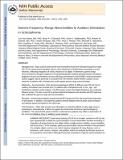| dc.contributor.author | Kwon, Jun Soo | |
| dc.contributor.author | O'Donnell, Brian F. | |
| dc.contributor.author | Wallenstein, Gene V. | |
| dc.contributor.author | Greene, Robert W. | |
| dc.contributor.author | Hirayasu, Yoshio | |
| dc.contributor.author | Nestor, Paul Gerard | |
| dc.contributor.author | Hasselmo, Michael E. | |
| dc.contributor.author | Potts, Geoffrey F. | |
| dc.contributor.author | Shenton, Martha Elizabeth | |
| dc.contributor.author | McCarley, Robert William | |
| dc.date.accessioned | 2016-09-14T19:51:24Z | |
| dc.date.issued | 1999 | |
| dc.identifier.citation | Kwon, Jun Soo, Brian F. O’Donnell, Gene V. Wallenstein, Robert W. Greene, Yoshio Hirayasu, Paul G. Nestor, Michael E. Hasselmo, Geoffrey F. Potts, Martha E. Shenton, and Robert W. McCarley. 1999. “Gamma Frequency–Range Abnormalities to Auditory Stimulation in Schizophrenia.” Archives of General Psychiatry 56 (11) (November 1): 1001. doi:10.1001/archpsyc.56.11.1001. http://dx.doi.org/10.1001/archpsyc.56.11.1001. | en_US |
| dc.identifier.issn | 0003-990X | en_US |
| dc.identifier.uri | http://nrs.harvard.edu/urn-3:HUL.InstRepos:28501417 | |
| dc.description.abstract | Background: Basic science studies at the neuronal systems level have indicated that gamma-range (30–50 Hz) neural synchronization may be a key mechanism of information processing in neural networks, reflecting integration of various features of an object. Furthermore, gamma-range synchronization is thought to depend on the glutamatergically mediated interplay between excitatory projection neurons and inhibitory neurons utilizing g-aminobutyric acid (GABA), which postmortem studies suggest may be abnormal in schizophrenia. We therefore tested whether auditory neural networks in patients with schizophrenia could support gamma-range synchronization. Methods: Synchronization of the electroencephalogram (EEG) to different rates (20–40 Hz) of auditory stimulation was recorded from 15 patients with schizophrenia and 15 sex-, age-, and handedness-matched control subjects. The EEG power at each stimulation frequency was compared between groups. The time course of the phase relationship between each stimulus and EEG peak was also evaluated for gamma-range (40 Hz) stimulation. Results: Schizophrenic patients showed reduced EEG power at 40 Hz, but not at lower frequencies of stimulation. In addition, schizophrenic patients showed delayed onset of phase synchronization and delayed desynchronization to the click train. Conclusions: These data provide new information on selective deficits in early-stage sensory processing in schizophrenia, a failure to support the entrainment of intrinsic gamma-frequency oscillators. The reduced EEG power at 40 Hz in schizophrenic patients may reflect a dysfunction of the recurrent inhibitory drive on auditory neural networks. | en_US |
| dc.language.iso | en_US | en_US |
| dc.publisher | American Medical Association (AMA) | en_US |
| dc.relation.isversionof | doi:10.1001/archpsyc.56.11.1001 | en_US |
| dc.relation.hasversion | https://www.ncbi.nlm.nih.gov/pmc/articles/PMC2863027/ | en_US |
| dash.license | LAA | |
| dc.title | Gamma Frequency–Range Abnormalities to Auditory Stimulation in Schizophrenia | en_US |
| dc.type | Journal Article | en_US |
| dc.description.version | Accepted Manuscript | en_US |
| dc.relation.journal | Arch Gen Psychiatry | en_US |
| dash.depositing.author | Shenton, Martha Elizabeth | |
| dc.date.available | 2016-09-14T19:51:24Z | |
| dc.identifier.doi | 10.1001/archpsyc.56.11.1001 | * |
| dash.authorsordered | false | |
| dash.identifier.orcid | 0000-0003-4235-7879 | en_US |
| dash.contributor.affiliated | Nestor, Paul | |
| dash.contributor.affiliated | Shenton, Martha | |
| dash.contributor.affiliated | McCarley, Robert William | |
| dc.identifier.orcid | 0000-0001-5705-7495 | |


